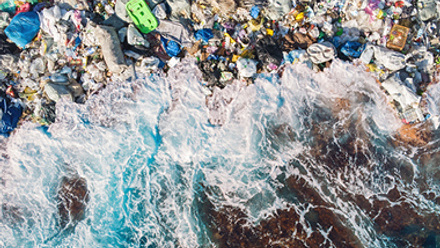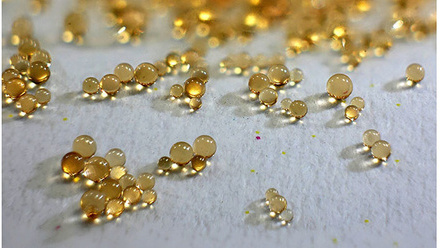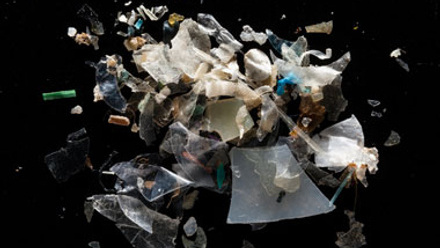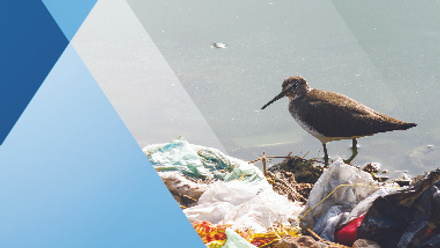Tire Wear and Microrubber Particles: From Problems to Solutions (2023)
Farhan R. Khan, Norwegian Research Centre (NORCE); Frank G.A.J. Van Belleghem, Pieter Jan Kole, Open Universiteit
Tire particles have become a growth area within the landscape of microplastic research. Global emissions of tire wear particles (TWP) per capita are estimated at around 0.8 kg/year, and recent reports have shown that micro-sized tire rubber, known as tire and road wear particles (TRWP), TWP and microrubber (MR), is a significant contributor to the plastic pollution of our seas. Tire rubber is a complex mixture of various rubbers, including styrene-butadiene (SBR), polybutadiene and natural rubber (NR), as well as substances such as carbon black, silica, zinc, sulphur, polycyclic aromatic hydrocarbons (PAHs) and other trace metals and antioxidants. Although some focus has recently shifted to the impact of 6PPD and its tranformation products, which was the subject of a separate session, the aim of this single sessionwas to cover the topic of tire particle in its entirety. Therefore, the fourth session on tire particles included five platform presentations and 29 posters covering five broad themes: (i) emissions and release; (ii) analysis and detection; (iii) environmental presence; (iv) ecotoxicology; and (v) regulation and stakeholder involvement.
Emissions and release
Sya Hoeke from the Open University of the Netherlands presented her study on a material system analysis on tire particles. The study aimed to develop a mitigation strategy based on an integrative, multi-stakeholder approach. In collaboration with the stakeholders, a map was created showing the supply chain, the involved stakeholders, and the emissions. The transdisciplinary approach with stakeholders was used to find blind spots, create clarity and build the trust necessary to arrive at a mitigation strategy that was endorsed by those stakeholders. The map was translated into a material system analysis depicting production, distribution, use, collection and repurposing in the Netherlands in the year 2021. The total initial release of tire particles was estimated at 22, 593 t/year. About half of these emissions are captured by entrapment in asphalt or removal in wastewater treatment plants, resulting in a release to the environment of 11,163 t/year, of which 83% goes tot soil and 17% to surface water. The results can be used by actors to test their own contribution to the material system analysis. In a next step, the presented results will be coupled to a fate transport model.
Analysis and detection
Kieran Evans from the University of Surrey, England, presented anovel method for analyzing and detecting tire rubber in road dust samples. Rubber particle detection in environmetnal samples necessitates sample pretreatment. Pyrolysis gas chromatography / mass spectrometry (GC/MS) and thermal extraction - desorption (TED) GC/MS are the current analytical procedures in use. The advantages of pyrolysis GC/MS are rapid pyrolysis at high temperatures and good detection limits. The disadvantages are that no gravimetric data is provided, and the sample size is small. TED GC/MS offers gravimetric data, allows for a larger sample size (100 mg) and has a constantly rising temperature using thermogravimetric analysis (TGA). In TGA, the weight of the sample is measured while it is gradually heated. The disadvantages are the long analysis time (about one hour) and the complex analytical set-up. The study focused on two analytical techniques using the same hardware: the conventional TGA GC/MS and the new Pyro TGA GC/MS. With TGA GC/MS, the sample is gradually heated (to 1000 degrees Celsius, for example) and the weight loss is measured by time interval. With Pyro TGA GC/MS, the sample is also heated with a constant temperature rise, but to a lower temperature (e.g., 600 degrees Celsius). The sample is left under that condition for about ten minutes while the GC/MS measurements continue. Run duration is approximately 20–25 minutes, sample size can be 100 mg, sample preparation is minimal, and gravimetric data is collected. Since the same hardware is used, multiple data can be collected with both methods.
Environmental presence
Kelly Moran from the San Francisco Estuary Institute, USA, studied the emissions of tire particles in California's San Francisco Bay area. The separate drainage system carries stormwater from roads directly into the bay. The study found that tire particles were the most common microplastic entering the bay via the drains. In a previous study, they found that 5x1012 tire particles entered the bay each year. These measurements were made with a 125 µm filter, which only captures 5–10% of the particle mass. In this study, the mass of tire particles entering the bay was estimated using two methods. Using the tire wear rate times distance traveled method, it was estimated that 15 x 106 kg/year per capita 1.9–2.4 kg/year. was emitted on the roads in the San Francisco Bay area, whereas the tires sales x tread mass loss method resulted in an estimation of 19 x 106 kg/year per capita 1.9–2.4 kg/year. Of these amounts, 0.3–0.8 x 106 kg/year reached the bay. Samples were taken from several locations in the bay and analyzed for substances such as 6PPD-quinone. The effluents entering the bay were estimated to average 60 ng/L 6PPD-quinone. The LC50 is 41 ng/L for juvenile coho salmon, indicating that the water from the drains is potentially lethal. A preliminary PNEC value of 10 ng/L was advised.
Ecotoxicology
Paul Benjamin Boisseaux from Exeter University, England, studied the chronic toxicity of tire tread particles and their leachates on Daphnia magna. The particles were a mixture of five different pristine tires. The cryo-milled particles and their leacheate were tested at both high and in environmentally realistic concentrations. For 21 days, the D. magna were examined for survival, particle uptake, morphometry and reproduction. At high concentrations, the particles were more toxic than the leachate alone. At environmentally relevant concentrations, tire particles induced hormesis, an increase in reproductive rate, whereas exposure to leachate decreased the reproductive rate. Tire particles led to an increase in the daphnids' tail volume, while leachate led to an increase in the length and width of the entire body. At high concentrations, tire particles were lethal, but even a t environmentally realistic concentrations, the reproduction and morphology development of D. magna were significantly impaired.
Regulation and stakeholder involvement
Steffan Foss Hansen from the Technical University of Denmark studied the need for environmental regulation for tires. Existing regulations on raw material manufacturing are the directives to reduce PAHs in ambient air (2004), REACH (2006), and the critical raw materials list (2017). There are two directives for tire manufacturing: the directive to prohibit PAHs in tires (2005) and the industrial emissions directive (2010). With regard to disposal, there is a directive to prevent landfilling (1999), the directive to prevent waste (2000), and the Waste Framework Directive (2008). However, none of these directly address the contribution of TWPs to the environment. TWPs and microplastics are not on the list of priority substances that Member States are required to monitor in surface waters under the Water Framework Directive. In REACH, tires are considered an "article," meaning that a technical dossier containing toxicological data must be submitted before they are allowed to be placed on the market. With more than 200 substances used in the manufacture of tires, and more that 120,000 different tires present, it should be clear that assessing the hazards of tires is virtually impossible. Another issue is the exclusion of polymers from registration under REACH. Existing regulations, while well intentioned, fail to adequately address the environmental impact of tire particles. A reassessment of TWP risks is essential, with a focus on transparency, reduced emissions and capturing particulate pollution as a top priority.
Overview
This year's session highlighted several significant achievements in TWP research, including the advancements in analytical methodology, the growing list of compounds detected in tire rubber, the increasing understanding of the ecotoxicity of the TWPs and leachates (e.g., 6PPD-quinone), and the advancement in stakeholder involvement in addressing the environmental impacts of tire particles. Although knowledge about TWP continues to increase, little is known about the ecological impacts of TWP accumulation in the environment and the human health impacts of TWP when it contrib utes to particulate air pollution. Furthermore, it is still a point of debate of how best to express our research with the tire industry in order to aid the development of tires with less environmental impact. That means we still have a lot of work ahead of us.
Author contact information: [email protected]





